Atlantis-Kurzanleitung
This is a short guide for Atlantis, which mainly describes online operation. The knowledge of the rules is assumed here.
Field
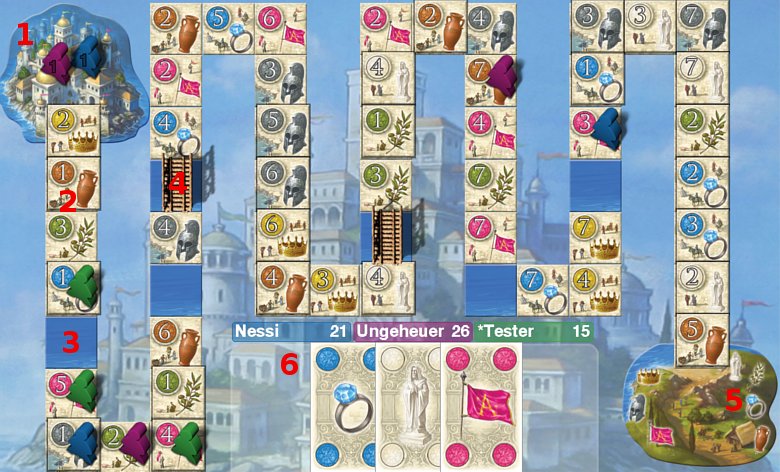
- Startfeld Atlantis
- Plots with values of 1-7
- Water gap
- Bridge
- Target field Mainland
- Player display
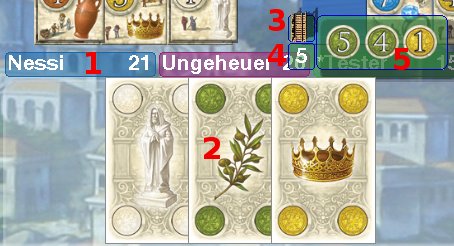
- Player name and current score
- Own handcards
- Bridge display (whether built or not)
- Handcards
- collected dot plates
Figure moving
To move a figure, the active player must first select and click a figure he wants to move. Then, for this figure, the possible goals that can be achieved with the aid of its motion maps are displayed.
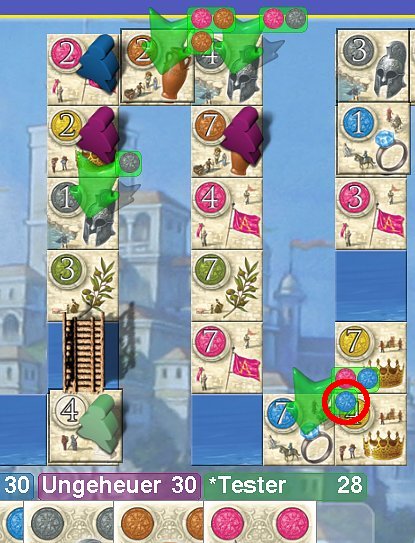
Example: Player Green has selected his figure at the bottom left. He's ever got a blue, gray, brown and pink hand map. The green arrows now show him what fields he could finish his train. On the right side of the green arrows it is indicated which maps it needs for this train. To draw on the gray one, for example, he only needs a gray map. To get to the gray four, it can first play the pink card. Since the pink two is occupied, it has to continue playing there and can play through the gray card to the next gray field, i.e. the gray four. To get to the brown two or the blue sevens, he has two options. It comes directly there with only one brown or blue card or, if it first plays the pink card, it also arrives with two cards. To select the desired destination, simply click on the corresponding color point next to the green arrow. So if green wanted to jump onto the blue screens with only one blue card, it would have to click the red-encircled point.
To build a bridge, click on the desired water field.

At the end of the building you click on the confirmation field.
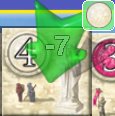
How much you have to pay for a path with water gaps is displayed when you drive with the mouse over the corresponding green target arrow.

If you have selected your train and clicked a color point, this window will open if you have to cross a water gap. In this way, it will be shown how much road tax is to be paid. It is possible to pay both with collected platelets and/or with hand cards.
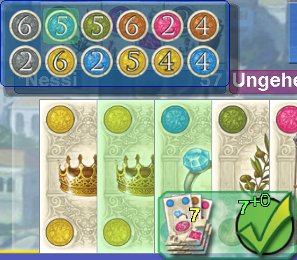
To do this, the mouse drives over its name and selects corresponding points and/or clicks on which of the hand cards. When you click the desired amount, you confirm with the green hook.
Attention: You can also overpay (constrained or inadvertently)! For example, if you only have to pay one, you only have higher points and no more hand cards, must: you are paying! Say, you have to give a higher-quality plate and give valuable points. If you don't pick up and re-elect, you should always make sure that the number of green checkers is displayed to avoid inadvertent overpayment.
Since the player has not collected a seven platelet here, he must mix: he chooses the blue five platelet and two of his handcards.

Special case: If a player with his handcards cannot make a valid train, he must take this round weeds. As compensation, he receives two handcards.
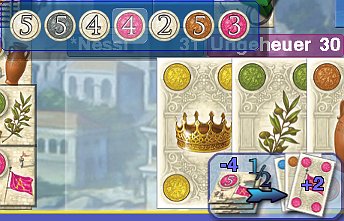
At the beginning of his train, a player can make a score Buy mobile cards. At the beginning of his train, he moves with the mouse over his name to call the point plates. Then it can select a plate and receives half of the value (with odd numbers rounded) in hand cards.

